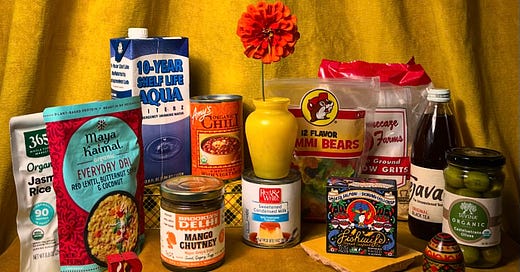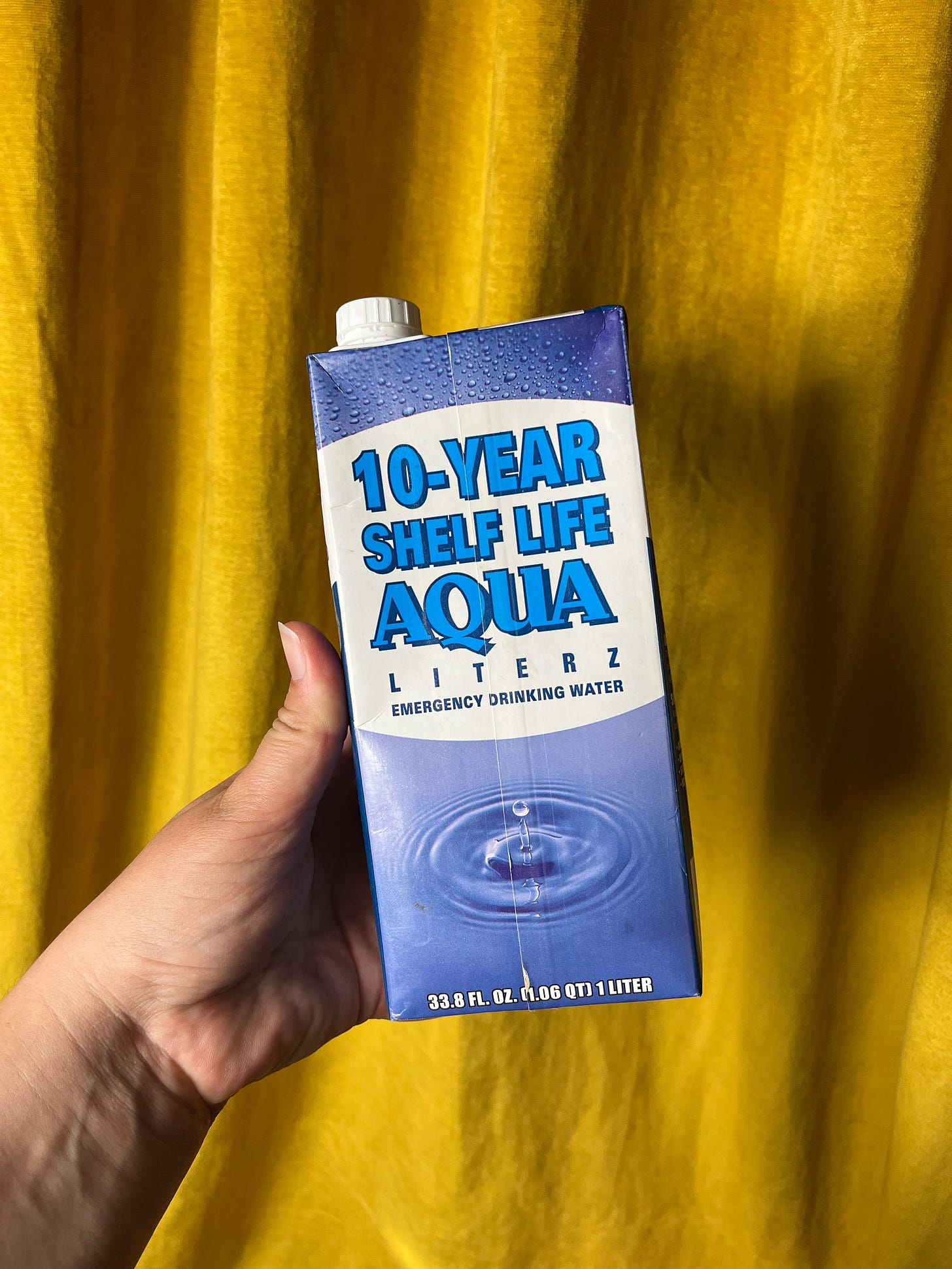Quick content note - this newsletter is about meal planning, and I go into detail about how I’m choosing foods for a prolonged power outage. I’m vehemently anti-diet culture and I don’t talk about calorie counts, macros, or clean eating. I do mention craving vegetables. If this type of topic isn’t for you, feel free to skip!
June 1st marked the beginning of hurricane season in Louisiana. In a perfect world, our preparations would already been completed, but this year I’ve found myself stuck.
We have the water and fire-proof safe for our documents, the headlamps and back-up batteries, and the small solar generator (enough to power an appliance for twelve hours, hopefully). We have the hand-cranked emergency radios that can charge a phone if you wind them frenetically enough. We’ve installed storm shutters on nearly every window and have stockpiled candles in the shed. What’s left is to finalize the food in our hurricane kit: enough food and water set aside for every member of the household for four days.
The official New Orleans disaster preparedness website divides a hurricane kit into two categories - the home kit, for sheltering in place, and the go bag, for evacuations. Most of my life I’ve opted to shelter in place. Prior to Hurricane Katrina, I was accustomed to evacuations being long, arduous, and expensive, often requiring me, a broke college student, to drive my 1990 volvo sedan (with an equally broken AC and radio!) through 12 hour traffic jams to the nearest safe city. I nearly didn't evacuate for Katrina. I was a server at a stuffy French restaurant uptown called The Flaming Torch, and was scheduled to work the lunch shift on August 29th. My boss was positive the storm would just miss us and that folks would be bored and hungry. If I didn’t come to work the next day, he told me, I wouldn’t have a job there anymore. I walked through the swinging doors into the kitchen where the chef, an acerbic man in perennially crisp whites, took me aside. He told me I needed to get the fuck out, that this was the big one, and that the job didn’t matter anymore. I took his advice (thank you Peter!). Ultimately both my apartment and the restaurant took on catastrophic damage, and I lost everything.
In my twenties, Hurricane Isaac became a citywide rager. One sliver of a block in my neighborhood retained power, and our local dive bar, Parasols, became the epicenter of the party - the only cold drinks around. With no work for the week, I had a torrid affair with a Canadian line cook (stuck in town until the airport reopened). My colleagues and I gorged ourselves on food lifted from the restaurant where we worked. The more food you remove prior to the storm, the less you have to clean later, though I’ll never forget my ice cream freezer. I’d forgotten to clear it and the smell of the rotten ice cream base still haunts me.
More recently, in 2021, Hurricane Ida knocked out the power to our home for six days. We were lucky - many others lost power for longer. My wife and I had just received a box of frozen grass-fed beef and pork from a local farm share. We spent that week scavenging for ice for our coolers and barbecuing every day. By the end of it we were so sick of meat that I nearly cried when we finally found an open market with fresh vegetables - even if they were only wilted bags of spinach, damp with condensation.
You’d think after all that, I’d always choose to evacuate, but staying behind during storms becomes a point of pride. If you’re well prepared, it can almost feel like camping in your own home. We also have three pets. The idea of packing two cats and a dog into a car for a week makes me break out in sweaty anxiety. Lastly, there’s the matter of climate change. Storms are brewing faster, and city officials have warned us there might not be time to order a mandatory evacuation, a complex process with its own legal mandates.
This year, I want to be well-prepared with meals that are vegetarian, mostly shelf stable, full of flavor, and require little to no cooking or water to prepare. We have a gas stove that will work without electricity, but turning it on in a house with no power in the New Orleans summer heat is a last resort. I want to run a tight ship within our refrigerator, forgoing buying or making any new condiments or jams for the rest of the summer - I have too many to use up as it is. Typically in our disaster situations, the national guard will set up distribution points for ice, water, and MRE’s (meal’s-ready-to-eat, or army rations). Our closest distribution point is in Armstrong Park, where we’d normally park to go see the philharmonic at the Mahalia Jackson Theater. We only ever go for ice and water, but the lines are long, so the less you need, the better. If your fridge and freezer are chock full, as ours were for Ida, you spend SO much time juggling foodstuffs between coolers and making judgment calls about spoilage. You also want to drive as little as possible - ideally, not at all. Gas is a precious commodity and tempers run hot at whatever gas stations are open. It’s not uncommon to see people openly carrying handguns while fueling up.
The goal is to have these meals ready to go before the storm is even on the radar. As soon as a potential hurricane is within spitting distance, the shops get slammed and your options will be slim. Plus the traffic is a drag. We already have some of the worst driving on earth, and it becomes more unhinged when everyone is stressed.
With all that being said, here’s my vision so far - minus the water, which we’ll already have, a gallon per person, per day. The potability of New Orleans tap water is dicey after even a strong rainstorm, and the likelihood of a Boil Water Advisory during a shelter in place order is strong.
Coarse ground coffee for the french press - nothing fancy, preferably vac-sealed.
Sweetened condensed milk (for the coffee), two cans.
Bottled iced tea, various flavors - these will live in the freezer and act as ice packs in the cooler until they defrost and I need a fun little beverage.
One quart of braised collard greens, frozen. The frozen quart will also act as an ice pack in my cooler until day three or four, when I’ll be desperate for green vegetables. I’m lucky to have a smallish Yeti (a gift from my brother), which keeps things frozen for a gloriously long time.
Grits. I usually have butter and cheese in the fridge, which I’ll keep in the cooler long enough to add to the grits. It will mean turning on the stove to cook the grits, but I’ll eat them with the braised greens and whatever eggs are left around, which I’ll have to use up one way or another regardless.
Rice, either precooked in shelf-stable packets, or regular if the pre-cooked kind strikes me as too dreary.
Those little vac sealed packs of dal - to eat with the rice, and to use up the mango chutney we invariably have in the fridge.
a tin of fish (?). To be honest I’ve never really gotten on board but my family likes them. I bought an eye-wateringly expensive tin for its charming packaging last week, so maybe that will bring some cheer during a storm.
My pal Kathryn suggested I jar some of Camilla Wynne’s Miso-Pickled Vegetables (from her first book, Preservation Society Home Preserves). I’m very tempted by the idea of a jar of crisp pickled green beans and carrots.
Peanut butter, olives, dates, prunes, and chocolate, for snacking.
Gummi bears and sour candy, for comfort.
Canned wine, also for comfort (easier to store cans in coolers than bottles)
Cat and dog food, natch.
This is where I’ve become stuck. It’s almost impossible to imagine what you’ll be hungry for during an uncertain potential future event, where it will be very, very hot. I’m tempted to graze the days away, but having three square meals is very grounding when everything else is topsy-turvy. Grocery planning has become excruciatingly boring under even the best of circumstances, and its banality takes on an unsettling tinge when cooking for disaster. Still, I know I need to plan for a few more meals in the kit.








They sell sweetened condensed milk in shelf stable nifty resealable squeezable pouches now! Easier to manage and store than cans
I grew up in New England, so not many hurricanes for me. I lived in NYC during hurricane Sandy which was such a surreal experience. I ended up staying with my ex in Manhattan, where we ended up being basically trapped for 7 days. We were lucky that his building was very fancy and most of our friends would spend their days with us. We'd cook for each other and take turns taking hot showers (everything below like 23rd street didn't have power). I wasn't a salaried employee at the time, and thankfully so, as all the salaries chefs and cooks had to clean out the walk-ins. They described a similar horror show to your rancid ice cream experience. I've now moved from an infrequent hurricane city to a (minor) earthquake city which has been a learning curve for sure. I'm always fascinated to see this deep dives into the reasoning behind what to keep in a shelter in place kit, and as always you never disappoint in your descriptions 💖